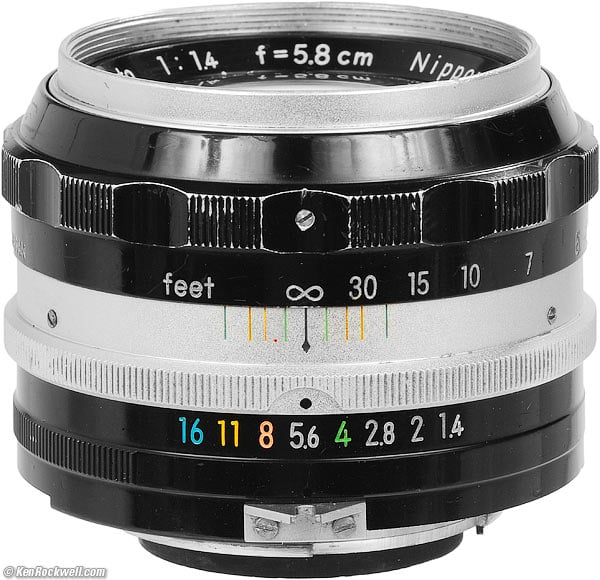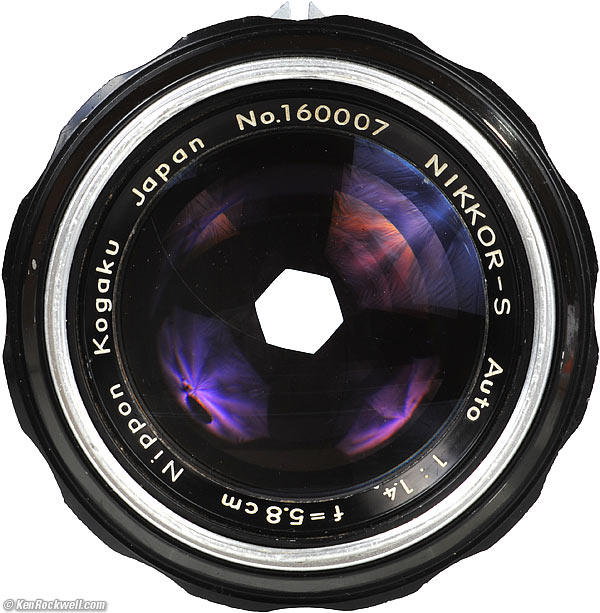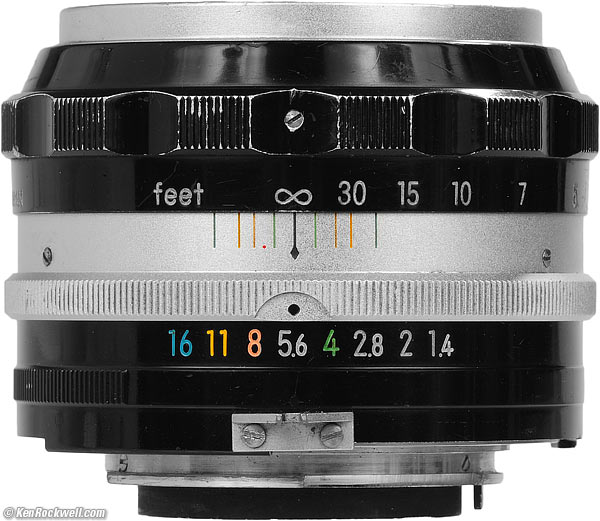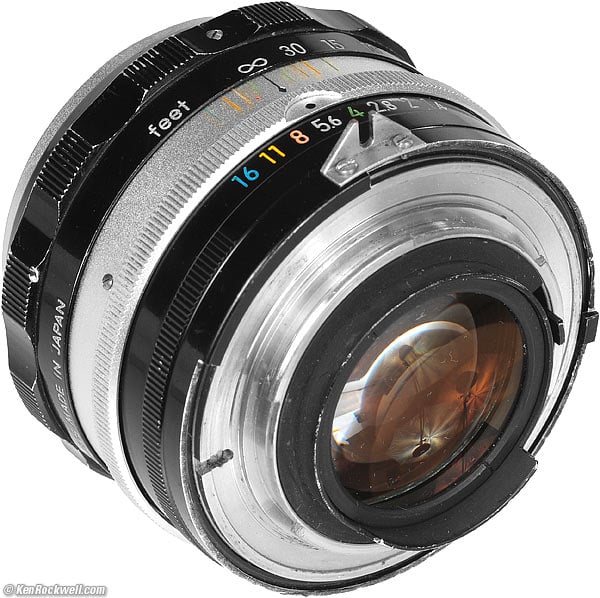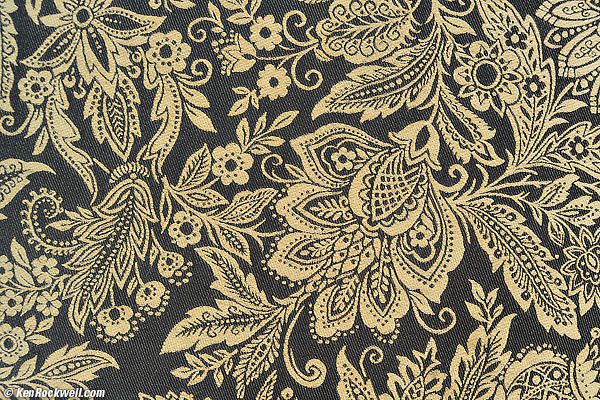Home Donate New Search Gallery Reviews How-To Books Links Workshops About Contact
Nikon 58mm f/1.4
5.8 cm NIKKOR-S (1959-1962)
© 2012 KenRockwell.com. All rights reserved.
Intro Specifications Performance Recommendations
Nikon F 58mm f/1.4 (52mm filters, 12.4 oz./350g, 2'/0.6m close focus, about $250 used). enlarge. This free website's biggest source of support is when you use any of these links, especially this direct link to this lens at eBay (see How to Win at eBay), when you get anything, regardless of the country in which you live. Thanks! Ken.
March 2014 Nikon Reviews Nikon Lenses All Reviews
NEW: Nikon 58mm f/1.4 G. December 2013.
NEW: Nikon 50mm and 58mm Bokeh Comparisons. December 2013.
Why Fixed Lenses Take Better Pictures
Sample Image File
Bubble time! Nikon D800E, SB-400 flash, f/8 at 1/125 at Auto ISO 220, Matrix meter, STANDARD Picture Control at +1 Saturation, 6 Sharpening, Auto White Balance adjusted to A3 M1. bigger or Original file.
More samples, more here and under Sharpness.
Introduction top
Intro Specifications Performance Recommendations
The Nikon F 58mm f/1.4 is Nikon's first f/1.4 SLR lens made from 1959 through 1962. This sample was made in 1961.
Nikon invented the world's first 50mm f/1.4 lens in 1950 for Nikon's rangefinder cameras. The rangefinder lens wouldn't work on the new Nikon F SLR camera because the back of the lens would be too close to clear the reflex mirror of an SLR, so Nikon increased the focal length so the back of the lens would clear the flipping reflex mirror. It wasn't until 1962 that Nikon was able to design a 50mm f/1.4 lens to work on its SLRs.
This lens was good enough to help Nikon win the 35mm market away from LEICA, who ruled the roost when Nikon introduced its F system in 1959. Of course ten years later by 1969, Nikon had completely beaten LEICA. LEICA survives today only as a rich man's toy; LEICA hasn't been about photography ever since the Nikon F beat it out of the market. Of course Nikon introduced an improved 50mm f/1.4 in 1962, so I won't credit this lens entirely with beating LEICA.
In its day, its focal length was marked as f = 5.8 cm, which is the same as 58mm.
This 58mm f/1.4 has nothing to do with the Nikon 58mm f/1.2 Noct-NIKKOR of 1977-1997.
This was never an AI or AI-s lens. As shipped, it only works with Nikon's SLRs made from 1959~1976.
Most of these lenses have been AI updated, and if they are, work perfectly with almost all FX and 35mm cameras.
If AI updated, works flawlessly with every manual focus Nikon ever made, from the original Nikon F of 1959 through the FM3a and today's FM-10.
If AI updated, on the D4, D800, D800E, D600, D3X, D3s, D3, D7000, D700, D300, D200, D2 and F6, use the "Non-CPU Lens Data" menu option to set 58mm and f/1.4 to get full color matrix metering, EXIF data and finder read-out of set aperture. It works great in aperture-preferred as well as manual modes on these cameras.
If AI updated, works perfectly on every professional 35mm camera (F, F2, F3, F4, F5, F6), and adds Matrix metering on the F6.
The meters of cheaper digital (D90, D5100 and below) and cheaper film cameras (N80 and below) will not couple (or work at all) with this lens at all, so you'll be on your own guessing exposure using the rear LCD or an external meter, or get a tiny Gossen Digisix meter and hotshoe adapter, or the free Pocket Light Meter app to meter manually.
See Nikon Lens Compatibility for details on your camera. Read down the "AII Converted" column for this lens, presuming it's been AI-updated.
If it's still in its original F-mount form, then read the Pre-AI column, and it won't mount on most cameras made since 1977.
Nikon made about 40,000 of these 58mm f/1.4 lenses.
Nikon 58mm f/1.4 F. enlarge.
Specifications top
Intro Specifications Performance Recommendations
Name
Nikon calls this the Nikon F NIKKOR-S 5.8 cm f/1.4.
"F" is Nikon's letter brand for its SLR cameras.
NIKKOR is Nikon's brand name for its better lenses.
-S means "sept," or seven elements.
5.8 cm is the focal length, equal to 58mm.
Optics top
7 elements in 6 groups.
It's single coated in amber and blue.
Diaphragm top
Nikon 58mm f/1.4 at f/5.6. enlarge.
6 straight blades.
Stops down to f/16.
Aperture Ring top
Yes.
Metal.
Full-stop clicks.
Close Focus top
2 feet.
0.6 meters.
Maximum Reproduction Ratio top
1:8.4
Angle of View top
40.8° diagonal on FX and 35mm.
27° diagonal on small-format DX.
Focal Length top
58mm.
On a small-format DX camera, this lens sees an angle-of-view similar to what an 88mm lens would see on a full-frame camera.
Hard Infinity Focus Stop? top
Yes.
This is great for astronomy; just turn to the stop and you have fixed laboratory-perfect focus all night.
Focus Scale top
Yes.
Depth-of-Field Scale top
Yes.
Color-coded lines correspond to each aperture.
Infra-Red Focus Index top
Yes: red dot in depth-of-field scale.
Filter Thread top
52mm, metal.
Does not rotate.
Size top
Nikon specifies 1.87" (47.5mm) extension from flange (2.35"/59.8mm overall) by 2.64" (67mm) diameter.
Weight top
Nikon specifies 12.35 oz. (350g).
Hood top
HS-1 metal snap-in.
HS-7 works, too.
Case top
CL- 6 Corinthian leather case.
Also #51 or CP-1 plastic bubble.
Quality top
Made in Japan.
Teleconverters top
Performance top
Intro Specifications Performance Recommendations
Overall Focus Coma Distortion Ergonomics Falloff
Filters Focus Breathing Ghosts Color Fringes Mechanics
Overall performance top
The Nikon 58mm f/1.4 is softer and less contrasty at f/1.4 than the newest lenses, but stopped down where we usually use it, it's about as good as Nikon's newest lens designs. The only things that really change over the decades are that Nikon learns to make lenses more cheaply and add fluff features like autofocus; the core optics don't change much.
Focus performance top
Manual focus is perfect.
Focus is as smooth as silk, relatively undamped and has no play.
Manual focus is flawless, both with a real camera like the Nikon F3, or with the three-way ( " > o < " ) manual focus indicators on newer cameras like the D4, D600, D800, D800E, D3X, D3s, D3, D700, F4, F5, F6 and most professional AF cameras.
Lesser digital cameras, like the D300s and down, usually have just one "OK" focus dot, which is not as precise as two arrows and a dot.
Coma performance top
Coma is weird smeared blobs that appear around bright points of light in the corners. They happen with fast and wide lenses at large apertures. Coma goes away as stopped down, and tends not to be seen in slower and tele lenses. Coma is an artifact of spherical aberration.
This lens is loaded with coma at large apertures.
See also saggital coma flare
Distortion performance top
The Nikon 58mm f/1.4 has moderate barrel distortion.
It can be corrected by plugging these figures into Photoshop's lens distortion filter. These aren't facts or specifications, they are the results of my research that requires hours of photography and calculations on the resulting data.
FX and 35mm |
||
∞ |
+2.5 |
+1 |
10' (3m) |
+2.5 |
© 2012 KenRockwell.com. All rights reserved.
Ergonomics performance top
Nikon F 58mm f/1.4. enlarge.
The Nikon 58mm f/1.4's ergonomics are great: you can focus and set aperture with you eyes closed by feel. You can't do that with the plastic wonders of today.
Focus flicks with one fingertip.
Falloff (darkened corners) performance top
Falloff on FX is as expected: some falloff at f/1.4, less at f/2, and all gone by f/2.8.
It won't be an issue at all on DX (see crop factor).
Filters, Use with performance top
There is no problem with vignetting, even with a thick rotating filter.
There's no need for newfangled "thin" filters.
Flare and Ghosts performance top
Pointed at the sun, there can be some overall blue haze. It's not a problem unless you ask for it by pointing your camera at the sun:
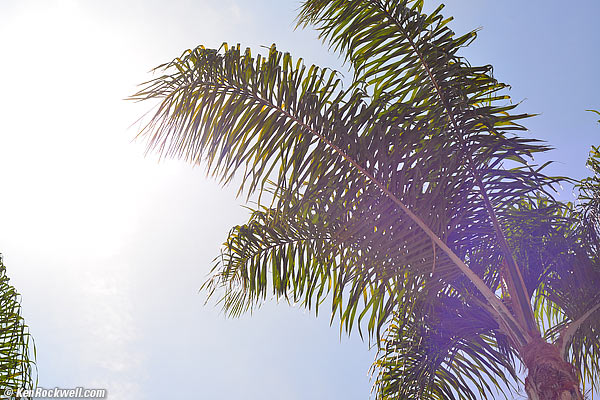
Flare pointed at the sun. D800E, ISO 100, f/8 at 1/500.
Focus Breathing performance top
Of interest mostly to cinematographers focusing back and forth between two subjects, the image from the Nikon 58mm f/1.4 AF-S gets larger as focused more closely.
It's a conventional unit-focusing lens, so no surprises here.
Lateral Color Fringes performance top
There are no lateral color fringes on the D3, which will correct them if the lens has any.
Mechanics performance top
Nikon 58mm f/1.4 F. enlarge.
Like all Nikkor manual focus lenses, the Nikon NIKKOR 58mm f/1.4 is built to the highest mechanical standards of any lens ever made.
Barrel Exterior
Anodized and enameled aluminum (black) and chromed brass (silver).
Filter Threads
Chromed brass.
Hood
Anodized aluminum.
Focus Ring
Anodized and enameled aluminum.
Focus Helicoids
Brass: smooth and silky with no play or need for damping grease.
Depth-of-Field Scale
Engraved into barrel and filled with different colors of paint.
Internals
All metal.
Aperture Ring
Cast aluminum, anodized and enameled.
Engraved markings filled with different colors of paint coded to the depth-of-field scale.
Automatic Aperture-Coupling Prong
Solid chromed, machined brass.
Mount
Dull-chromed brass.
Markings
Engraved into the metal and filled with paint.
Identity and Serial Number
On the front of the lens, inside the filter ring, engraved into the metal and filled with paint.
Moisture Seal at Mount
No.
Noises When Shaken
Mild clicking from the diaphragm blades and actuation system.
Made in
Japan.
Sharpness performance top
Fabric. Nikon D800E, f/8 at 1/250 at Auto ISO 100, Matrix meter, VIVID Picture Control at +3 Saturation, 6 Sharpening, Auto White Balance adjusted to A3 M1.) Original file.
At macro ranges, it's very sharp stopped down, but less so in the corners.
Like most f/1.4 lenses of its era, it has a curved field, especially up close. The corners could be sharper if the subject was curved.
Getting ready. Nikon D800E, SB-400 flash, f/8 at 1/125 at Auto ISO 160, Matrix meter, STANDARD Picture Control at +1 Saturation, 6 Sharpening, Auto White Balance adjusted to A3 M1.) bigger or Original file.
For actual use, it's the same as every other lens.
Warning 1: Image sharpness depends more on you than your lens.
Warning 2: Lens sharpness doesn't mean much to good photographers.
With those caveats, the 58mm f/1.4 F is soft at f/1.4, and sharp at smaller apertures.
At f/1.4
The 58mm f/1.4 is very soft throughout most of the image at f/1.4.
At f/2
It's a little better at f/2, but still very soft throughout most of the image.
At f/2.8
It's greatly improved at f/2.8.
Most of the image is super-sharp, but it's still blurrier on the sides.
At f/4
Most of the image is super-sharp, and the sides are much better than at f/2.8 - but still a little blurry.
At f/5.6
Most of the image is super-sharp, and the sides are somewhat better than at f/4 - but still a little blurry.
At f/8
Almost all of the image is super-sharp, with the farthest corners still a bit softer.
This is the optimum aperture for most of the image.
At f/11
The corners get a little sharper, while most of the image is a little softer due to diffraction.
At f/16
The corners are the sharpest, while there rest of the image is softer due to diffraction.
Sunstars performance top
With its straight 6-bladed diaphragm, the 58mm f/1.4 makes boring 6-pointed sunstars on bright points of light.
Recommendations top
Intro Specifications Performance Recommendations
The Nikon 58 1.4 has optics good enough to create astounding images, but it is Nikon's weakest normal lens. Each newer version of 50mm f/1.4 lens is progressively sharper at f/1.4, although they're all pretty much the same at f/8.
I wouldn't go out of my way looking for one of these, but if you have one, you'll make images as good as with any other lens.
The price seems to be too high; fueled I suspect more by collectors than actual photographers. If you're a photographer, the 50mm f/1.4 AI and 50mm f/1.4 AI-s are much, much better, and sell for the same price.
Deployment top
I'd pitch the flat Nikon cap that came with this lens new, and get a new "pinch" type cap. I'm not kidding: the new fatter caps are much easier to use in the field.
I'd leave either a 52mm Nikon Clear (NC - UV) filter, or a 52mm Hoya Super HMC UV on the lens at all times. I would leave the hood at home.
If I was working in nasty, dirty areas, I'd forget the cap, and use an uncoated 52mm Tiffen UV filter instead. Uncoated filters are much easier to clean, but more prone to ghosting.
For color slides like Velvia 50, I use an old Nikon A2 or new 52mm Hoya HMC 81A outdoors.
For B&W film outdoors, I'd use an old Nikon Y48 or O56, or a new 52mm Hoya HMC K2 Yellow or 52mm Hoya HMC Orange.
Help me help you top
I support my growing family through this website, as crazy as it might seem.
The biggest help is when you use any of these links when you get anything, regardless of the country in which you live. It costs you nothing, and is this site's, and thus my family's, biggest source of support. These places have the best prices and service, which is why I've used them since before this website existed. I recommend them all personally.
If you find this page as helpful as a book you might have had to buy or a workshop you may have had to take, feel free to help me continue helping everyone.
If you've gotten your gear through one of my links or helped otherwise, you're family. It's great people like you who allow me to keep adding to this site full-time. Thanks!
If you haven't helped yet, please do, and consider helping me with a gift of $5.00.
As this page is copyrighted and formally registered, it is unlawful to make copies, especially in the form of printouts for personal use. If you wish to make a printout for personal use, you are granted one-time permission only if you PayPal me $5.00 per printout or part thereof. Thank you!
Thanks for reading!
Mr. & Mrs. Ken Rockwell, Ryan and Katie.
Home Donate New Search Gallery Reviews How-To Books Links Workshops About Contact

